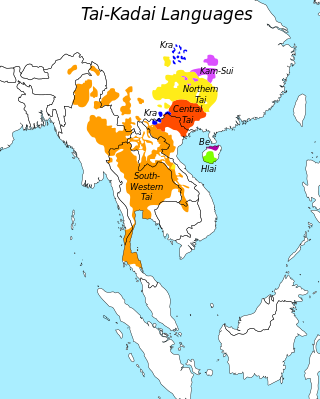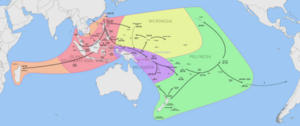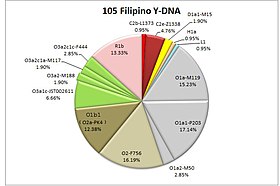
The term Kra–Dai peoples or Kra–Dai-speaking peoples refers collectively to the ethnic groups of southern China and Southeast Asia, stretching from Hainan to Northeast India and from southern Sichuan to Laos, Thailand and parts of Vietnam, who not only speak languages belonging to the Kra–Dai language family, but also share similar traditions, culture and ancestry.

The term Negrito refers to several diverse ethnic groups who inhabit isolated parts of Southeast Asia and the Andaman Islands. Populations often described as Negrito include: the Andamanese peoples of the Andaman Islands, the Semang peoples of Peninsular Malaysia, the Maniq people of Southern Thailand, as well as the Aeta of Luzon, the Ati and Tumandok of Panay, the Mamanwa of Mindanao, and about 30 other officially recognized ethnic groups in the Philippines.

Melanesians are the predominant and indigenous inhabitants of Melanesia, in an area stretching from New Guinea to the Fiji Islands. Most speak one of the many languages of the Austronesian language family or one of the many unrelated families of Papuan languages. There are several creoles of the region, such as Tok Pisin, Hiri Motu, Solomon Islands Pijin, Bislama, and Papuan Malay.
Genetics and archaeogenetics of South Asia is the study of the genetics and archaeogenetics of the ethnic groups of South Asia. It aims at uncovering these groups' genetic histories. The geographic position of the Indian subcontinent makes its biodiversity important for the study of the early dispersal of anatomically modern humans across Asia.

Haplogroup F is a human mitochondrial DNA (mtDNA) haplogroup. The clade is most common in East Asia and Southeast Asia. It has not been found among Native Americans.
Haplogroup K or K-M9 is a genetic lineage within human Y-chromosome DNA haplogroup. A sublineage of haplogroup IJK, K-M9, and its descendant clades represent a geographically widespread and diverse haplogroup. The lineages have long been found among males on every continent except Antarctica.

Haplogroup O, also known as O-M175, is a human Y-chromosome DNA haplogroup. It is primarily found among populations in Southeast Asia and East Asia. It also is found in various percentages of populations of the Russian Far East, South Asia, Central Asia, Caucasus, Crimea, Ukraine, Iran, Oceania, Madagascar and the Comoros. Haplogroup O is a primary descendant of haplogroup NO-M214.
Haplogroup O-M122 is an Eastern Eurasian Y-chromosome haplogroup. The lineage ranges across Southeast Asia and East Asia, where it dominates the paternal lineages with extremely high frequencies. It is also significantly present in Central Asia, especially among the Naiman tribe of Kazakhs.
Haplogroup P also known as P-F5850 or K2b2 is a Y-chromosome DNA haplogroup in human genetics. P-F5850 is a branch of K2b, which is a branch of Haplogroup K2 (K-M526).
In human mitochondrial genetics, haplogroup E is a human mitochondrial DNA (mtDNA) haplogroup typical for the Malay Archipelago. It is a subgroup of haplogroup M9.
In human genetics, Haplogroup O-M119 is a Y-chromosome DNA haplogroup. Haplogroup O-M119 is a descendant branch of haplogroup O-F265 also known as O1a, one of two extant primary subclades of Haplogroup O-M175. The same clade previously has been labeled as O-MSY2.2.

In human mitochondrial genetics, Haplogroup Y is a human mitochondrial DNA (mtDNA) haplogroup.

In the course of the peopling of the World by Homo sapiens, East Asia was reached about 50,000 years ago. The "recent African origin" lineage of 70 kya diverged into identifiable East Eurasian and West Eurasian lineages by about 50 kya. This early East Asian lineage diverged further during the Last Glacial Maximum, contributing outgoing from Mainland Southeast Asia significantly to the peopling of the Americas via Beringia about 25 kya. After the last ice age China became cut off from neighboring island groups. The previous phenotypes of early East Asians became either replaced or prevailed among more geographically distant groups.

The prehistory of the Philippines covers the events prior to the written history of what is now the Philippines. The current demarcation between this period and the early history of the Philippines is April 21, 900, which is the equivalent on the Proleptic Gregorian calendar for the date indicated on the Laguna Copperplate Inscription—the earliest known surviving written record to come from the Philippines. This period saw the immense change that took hold of the archipelago from Stone Age cultures in 50000 BC to the emergence of developed thalassocratic civilizations in the fourth century, continuing on with the gradual widening of trade until 900 and the first surviving written records.

Since H. Otley Beyer first proposed his wave migration theory, numerous scholars have approached the question of how, when and why humans first came to the Philippines. The current scientific consensus favors the "Out of Taiwan" model, which broadly match linguistic, genetic, archaeological, and cultural evidence.
Population genetics research has been conducted on the ancestry of the modern Turkish people in Turkey. Such studies are relevant for the demographic history of the population as well as health reasons, such as population specific diseases. Some studies have sought to determine the relative contributions of the Turkic peoples of Central Asia, from where the Seljuk Turks began migrating to Anatolia after the Battle of Manzikert in 1071, which led to the establishment of the Anatolian Seljuk Sultanate in the late 11th century, and prior populations in the area who were culturally assimilated during the Seljuk and the Ottoman periods.

The tables below provide statistics on the human Y-chromosome DNA haplogroups most commonly found among ethnolinguistic groups and populations from East and South-East Asia.

Haplogroup O2a2b1a1-M117 or Haplogroup O2a2b1a1-M117 is a subclade of O2a2b1-M134 that occurs frequently in China and in neighboring countries like Bhutan, Nepal, and Korea, also found among Sino-Tibetan language speaking people.
Southeast Asia was first reached by anatomically modern humans possibly before 70,000 years ago. Anatomically modern humans are suggested to have reached Southeast Asia twice in the course of the Southern Dispersal migrations during and after the formation of a distinct East Asian clade from 70,000 to 50,000 years ago.
This article summarizes the genetic makeup and population history of East Asian peoples and their connection to genetically related populations, as well as Oceanians and partly, Central Asians and South Asians, which are collectively referred to as "East Eurasians" in population genomics.













